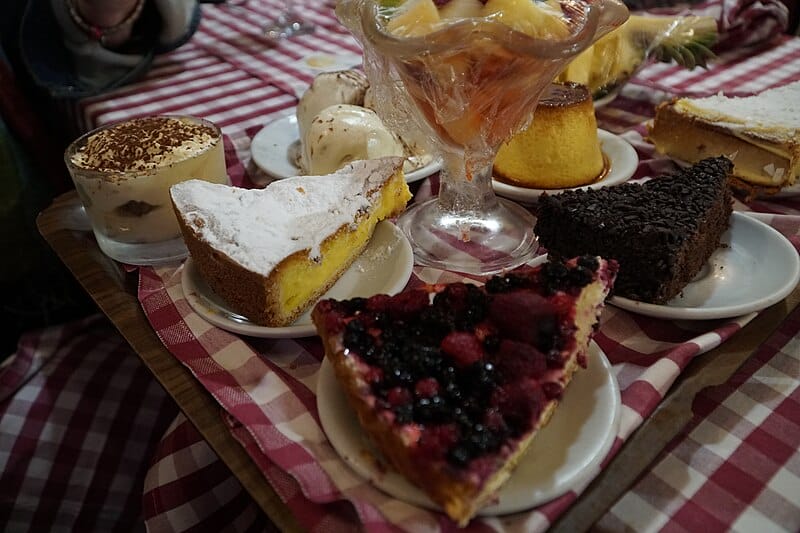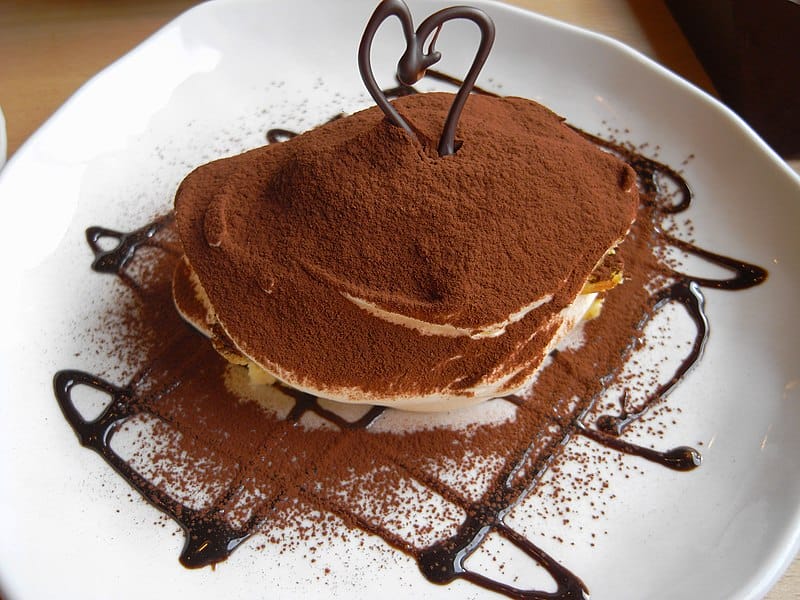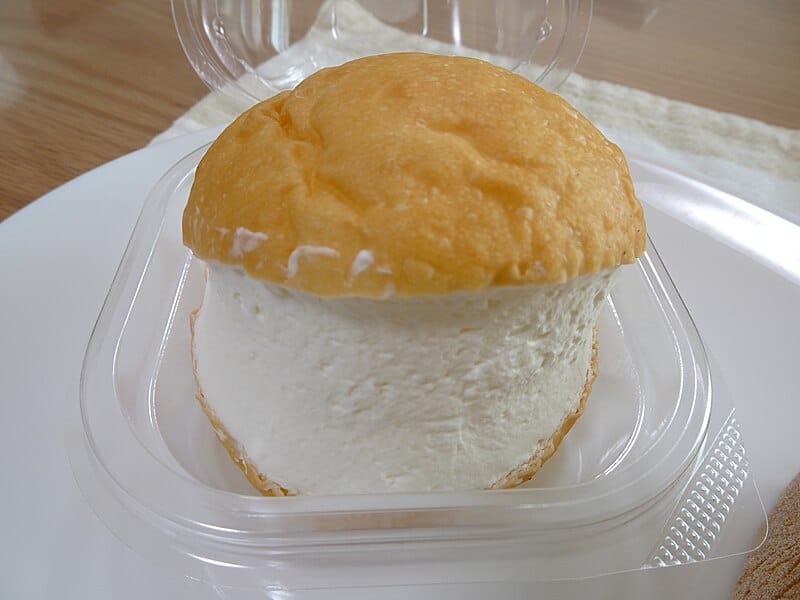What could we say about Roman desserts? Similar to today’s Italy, sweets were very important part of ancient Roman cuisine. We are not sure if people who live today inherited this from the Romans but we are sure that the Romans had a sweet tooth, and they enjoyed desserts. Some desserts were simple and fruit-based while some were rich, like cakes and pastries.

Source: Deb Nystrom from Ann Arbor, Michigan, USA, CC BY 2.0 https://creativecommons.org/licenses/by/2.0, via Wikimedia Commons
Like in many other things, Roman cuisine took the best from other civilizations and improved it. The Romans were influenced by the Greeks and the Egyptians and their culinary practices. The same applies for desserts. But Romans weren’t only borrowers of other people’s culture and recipes. They also developed unique desserts, made from local ingredients. And what is even more important, many traditional Roman desserts are still being eaten in Italy, and other places, even today. Yes, Rome still continues to influence our world today in so many ways.
Key Takeaways
- Roman desserts were a very important part of ancient Roman cuisine and many Romans enjoyed sweets at the end of the meal.
- Romans borrowed many dessert recipes from the Greeks and Egyptians but also developed their own unique desserts.
- Today, traditional Roman desserts are still enjoyed in Italy and around the world.
Influence of Ancient Romans on Modern Sweets
How big is Roman dessert’s influence on today’s cuisine? Well, many of the desserts that we enjoy today have their roots in ancient Rome. For example, the cheesecake, which we all love, was first mentioned in a cookbook called “De Re Coquinaria” by Apicius. This cookbook was written in the 1st century AD. So, it was during the time of the Roman Empire. Traditional Roman Desserts

Libum
Let’s start with libum. It was a kind of cake, made with wheat flour, cheese, and honey. The cake was baked, and it was served warm. This dessert even had a religious role since it was used during some ceremonies.
Savillum
And now, the ancient cheesecake, called savillum. Of course, it was different than today’s version and it was made from ricotta cheese, honey, and flour. Some other ingredients could be bay leaves or cinnamon but these were not a must.
Maritozzo con la Panna
Maritozzo con la Panna was, and still is, a popular Roman pastry. It is split down the middle and filled with fresh cream. One of the popular desserts today that has been enjoyed by Romans for generations.
Some can even make the maritozzo at home, by using flour, sugar, eggs, and butter. In order to do it properly the dough should be left to rise before being baked until the color becomes golden brown. The next step is crucial. Although it already looks delicious, the maritozzo should be left alone to cool down. Once the maritozzo has cooled, it is the right moment to split it down the middle and fill it with whipped cream. The result can be seen in the picture below.

Source: RuinDig, CC BY 4.0 https://creativecommons.org/licenses/by/4.0, via Wikimedia Commons
If you are as skilled a baker as I am, you could also find this Roman dessert in bakeries and cafes throughout the city, and the whole of Italy. It is best to eat it for breakfast as a main meal or after the main meal later in the day.
Torta di Ricotta e Visciole
Torta di Ricotta e Visciole is a traditional dessert from Roman cuisine. It is a perfect example of the influence of other cultures on Rome, particularly Jewish influence. It is a crumbly pastry filled with ricotta cheese and sour cherries (visciole). These two are the most important ingredients. The pastry, on the other hand, is made form plain ingredients, and all of them you can probably find in the house: flour, butter, sugar, and egg yolks. The hard part is making it, so I will go outside and eat it in some coffee.
This dessert is a perfect combination of sweet and sour. Cherries and cheese give it that mix that will leave you asking for more. It usually goes best with coffee, after the meal.
Pangiallo Romano
When you see the Pangiallo Romano on the table, that probably means it’s the Christmas season in Rome. The name of the cake is the “yellow bread,” because of its color, and many Italians are reminded of the holiday season when they see it.
The recipe for Pangiallo Romano is very old and dates to the time of the Roman Empire. Because of that, there are many different variations of the recipe. But almost all need to have that one thing that makes it a special Roman dessert, its golden glaze. This gaze is made by mixing honey, sugar, and egg whites together. Looks beautiful, and tastes even better.
Crostata di Visciole
Crostata di Visciole is a classic Roman dessert. What makes something a classic Roman dessert? Good taste and simplicity. Here, you just have to use a sour cherry tart, fresh fruit, and buttery pastry. Of course, there are some other ingredients and you need some baking but these are the most important. And who doesn’t like cherries?
To make this Roman dessert at home, you need to prepare pastry in the beginning. You know, the standard stuff, flour, butter, sugar, and a little bit of salt. After that, the next in line is the filling, and for that, we need cherries, sugar, and flour. Pour the one into another and bake it in the oven until it is golden brown. And here you go, you have Crostata di Visciole.
Roman Globi
Roman Globi is a Roman dessert, so ancient that it was documented in Roman Empire cookbooks. The book of Apicius mentions it. It is made from a mixture of the best it is, cheese and also semolina. But that’s not all. It needs to be fried to get that golden color and crispy taste in the mouth. After that, we put honey around the mixture. You can use all sorts of cheese for this dessert, but the two most used are ricotta and goat cheese.
Mustaceum Cake
One of the popular desserts in ancient Rome was the Mustaceum cake. It had a special role in one of the most important moments for every person in the Roman Empire, weddings. And during the weddings, they served Mustaceum cake. So, it was very important Roman dessert for some very important occasion.
The ingredients were usual, flour, honey, and must, a sweet grape juice. But the ingredients weren’t everything, the shape of the cake was also important. The Mustaceum cake was shaped like a rhombus, and some dried fruits were put on top of it. And there was a lot of symbolism. Guests would share the cake and wish the newlyweds a sweet life. The breaking of the cake was also seen as a symbol of the couple’s commitment to each other.
People Also Ask:
What are some classic Roman desserts?
Ancient Rome has a rich history of desserts that are still enjoyed today. One of the most famous desserts is the “honey cake,” or “placenta,” which was made with honey, cheese, and spelt flour. Another popular Roman dessert was the “globus,” a sweet pastry made with eggs, flour, and honey. Ancient Romans also enjoyed a variety of fruit-based desserts, such as “mulsum,” a sweet wine mixed with honey and spices, and “frumenty,” a porridge made with spelt, milk, and honey.
How did ancient Romans incorporate fruit into their desserts?
Fruit was a popular ingredient in ancient Roman desserts. Fruits such as figs, dates, and pomegranates were often baked into cakes and pastries. Ancient Romans also enjoyed fruit-based desserts such as “mulsum,” a sweet wine mixed with honey and spices, and “frumenty,” a porridge made with spelt, milk, and
Could you provide examples of desserts that were popular in ancient Rome?
Some of the most popular Roman desserts are “honey cake,” or “placenta,” which was made with honey, cheese, and spelt flour. Another popular Roman dessert was the “globus,” a sweet pastry made with eggs, flour, and honey. Ancient Romans also enjoyed a variety of fruit-based desserts, such as “mulsum,” a sweet wine mixed with honey and spices, and “frumenty,” a porridge made with spelt, milk, and honey.
Hello, my name is Vladimir, and I am a part of the Roman-empire writing team.
I am a historian, and history is an integral part of my life.
To be honest, while I was in school, I didn’t like history so how did I end up studying it? Well, for that, I have to thank history-based strategy PC games. Thank you so much, Europa Universalis IV, and thank you, Medieval Total War.
Since games made me fall in love with history, I completed bachelor studies at Filozofski Fakultet Niš, a part of the University of Niš. My bachelor’s thesis was about Julis Caesar. Soon, I completed my master’s studies at the same university.
For years now, I have been working as a teacher in a local elementary school, but my passion for writing isn’t fulfilled, so I decided to pursue that ambition online. There were a few gigs, but most of them were not history-related.
Then I stumbled upon roman-empire.com, and now I am a part of something bigger. No, I am not a part of the ancient Roman Empire but of a creative writing team where I have the freedom to write about whatever I want. Yes, even about Star Wars. Stay tuned for that.
Anyway, I am better at writing about Rome than writing about me. But if you would like to contact me for any reason, you can do it at contact@roman-empire.net. Except for negative reviews, of course. 😀
Kind regards,
Vladimir
